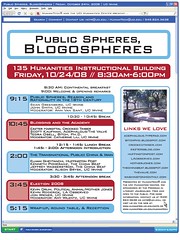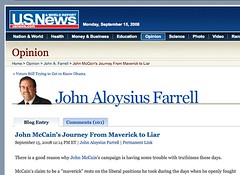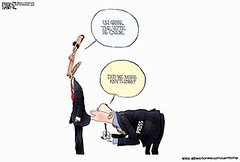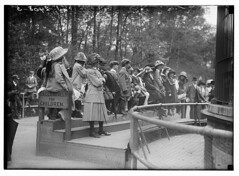 Public Spheres Blogospheres Flyer (Photo credit: eszter)
Public Spheres Blogospheres Flyer (Photo credit: eszter) it's good AND ABOUT FREAKIN' TIME that mainstream media used accurate headlines; or, "John McCain's Journey From Maverick to Liar" (Photo credit: davidsilver)
it's good AND ABOUT FREAKIN' TIME that mainstream media used accurate headlines; or, "John McCain's Journey From Maverick to Liar" (Photo credit: davidsilver) Mainstream Media Hard at Work (Photo credit: wstera2)
Mainstream Media Hard at Work (Photo credit: wstera2) Children at N.Y. Zoo (LOC) (Photo credit: The Library of Congress)
Children at N.Y. Zoo (LOC) (Photo credit: The Library of Congress)Top Journals in Anthropology
.....subordination of Latinos depended on reducing human beings with multiple, varied, and broad identities into narrower and dehumanized categories like “laborer” or “alien.”
In referencing the raids, Mr. Obama invoked cultural models (Quinn and Holland 1987)—that is, socially created ideas that are broadly extant in society that guide and shape both how we think and act—to appeal to an audience that was frustrated and angered by the dramatic recent increase in workplace raids and by the community upheaval those raids had caused. As Obama knew, invoking parents' separation from children, children's terror, and children leaving school uncertain of whether adults in their life would be home to greet them are each powerfully emotive story lines and lead most listeners to feel sympathy for the disrupted, to feel solidarity with Obama in his criticism. Candidate Obama could have referenced other storylines and details related to the raids. It is telling that he did not.
.....our goal is to look at how community, migration, newcomers, workplace, school, Latinos, and children were all being understood regionally in mainstream print media during the second half of the first decade of the 21st century by considering the cultural models used by small and large local print media sources in their depictions of the ICE raids and their aftermaths. In particular we are interested in seven nationally prominent raids. Six were the concurrent ICE raids that involved six Swift meatpacking plants just before Christmas in 2006 and the seventh was the May 2008 ICE raid at a kosher meat-processor in Postville, Iowa.
Print media are not the traditional data source for the anthropology of education, but we turn to them, nonetheless, for a number of reasons. First, although we think our focus on how children, schools, and teachers (among others) are understood suffices to put this inquiry within the traditional boundaries of our subdiscipline, we also note that print media have a popular educational role; they provide the content that the reading public consumes. We agree that, just as in schools where what is taught is not necessarily what is learned (Erickson 1987), what is printed in the media is not necessarily what readers ultimately internalize or concur with. Nonetheless, print media depictions become a starting point for what is imaginable, a point we will return to in the subsequent discussion of cultural models
.....in this public space not all prospective public voices were equally welcome, with certain opinions relegated to “reader comments” or “letters-to-the-editor” (or perhaps excluded altogether) instead of given the imprimatur of a reported story or editorial.
While a traditional ethnography could intriguingly illuminate how heterogeneous members of at least one of the raided communities reacted, the intent here is to identify what might pass as mainstream, local, public-sphere shaping “elites” as they drafted one of the most obvious and accessible records of what the raids locally meant. ....it is our contention that mainstream regional media largely reflect dominant public attitudes even as they help shape them.
Fairclough argues that mainstream media, as dominant voices in public discourse, can shape the particular definitions of words, act as stage directions for social interaction, bound that same stage, and reaffirm the discourse provider's identity. Making this less abstract, newspaper stories in Flyover Country played framing roles in determining what words were used to talk about the ICE raids and those affected, provided a venue for public meaning-making related to those raids, delineated which interpretations were mainstream and which were not seen in such a light, and reiterated their own authority as mainstream “sensible” news sources.
Quinn and Holland write:Undeniably, a great deal of order exists in the natural world we experience. However, much of the order we perceive in the world is there only because we put it there. That we impose such order is even more apparent when we consider the social world, in which institutions such as marriage, deeds such as lying, and customs such as dating happen at all because the members of a society presume them to be.
Terms like “newcomer” and “illegal alien” can both be invoked to describe the same person, but the choice of one versus the other is powerfully consequential for how we understand the invocation and the way we subsequently view and act toward the referent. In invoking children (and the other terms), it is unlikely that Obama thought he was introducing something new to his immediate audience. Rather he was invoking themes and knowledge that his audiences, at the speech and those accessed through media coverage, brought with them. Cultural models are bigger than just particular turns-of-phrase because they invoke a much larger body of experience, history, and senses of identity or position. They link the invoker and the invoked through the shared solidarity of agreeing on socially created facts.
One reason the charge has become so common is that the law does not require




ICE Raids, Children, Media, and Making Sense of Latino Newcomers in Flyover Country
Speaking recently to the National Council of La Raza, Barack Obama told the audience what it wanted to hear when he said, “The system isn't working . . . when communities are terrorized by ICE immigration raids—when nursing mothers are torn from their babies, when children come home from school to find their parents missing, when people are detained without access to legal council.”
—Ruben Navarette, 2008,.....subordination of Latinos depended on reducing human beings with multiple, varied, and broad identities into narrower and dehumanized categories like “laborer” or “alien.”
In referencing the raids, Mr. Obama invoked cultural models (Quinn and Holland 1987)—that is, socially created ideas that are broadly extant in society that guide and shape both how we think and act—to appeal to an audience that was frustrated and angered by the dramatic recent increase in workplace raids and by the community upheaval those raids had caused. As Obama knew, invoking parents' separation from children, children's terror, and children leaving school uncertain of whether adults in their life would be home to greet them are each powerfully emotive story lines and lead most listeners to feel sympathy for the disrupted, to feel solidarity with Obama in his criticism. Candidate Obama could have referenced other storylines and details related to the raids. It is telling that he did not.
.....our goal is to look at how community, migration, newcomers, workplace, school, Latinos, and children were all being understood regionally in mainstream print media during the second half of the first decade of the 21st century by considering the cultural models used by small and large local print media sources in their depictions of the ICE raids and their aftermaths. In particular we are interested in seven nationally prominent raids. Six were the concurrent ICE raids that involved six Swift meatpacking plants just before Christmas in 2006 and the seventh was the May 2008 ICE raid at a kosher meat-processor in Postville, Iowa.
Print media are not the traditional data source for the anthropology of education, but we turn to them, nonetheless, for a number of reasons. First, although we think our focus on how children, schools, and teachers (among others) are understood suffices to put this inquiry within the traditional boundaries of our subdiscipline, we also note that print media have a popular educational role; they provide the content that the reading public consumes. We agree that, just as in schools where what is taught is not necessarily what is learned (Erickson 1987), what is printed in the media is not necessarily what readers ultimately internalize or concur with. Nonetheless, print media depictions become a starting point for what is imaginable, a point we will return to in the subsequent discussion of cultural models
.....in this public space not all prospective public voices were equally welcome, with certain opinions relegated to “reader comments” or “letters-to-the-editor” (or perhaps excluded altogether) instead of given the imprimatur of a reported story or editorial.
While a traditional ethnography could intriguingly illuminate how heterogeneous members of at least one of the raided communities reacted, the intent here is to identify what might pass as mainstream, local, public-sphere shaping “elites” as they drafted one of the most obvious and accessible records of what the raids locally meant. ....it is our contention that mainstream regional media largely reflect dominant public attitudes even as they help shape them.
Fairclough argues that mainstream media, as dominant voices in public discourse, can shape the particular definitions of words, act as stage directions for social interaction, bound that same stage, and reaffirm the discourse provider's identity. Making this less abstract, newspaper stories in Flyover Country played framing roles in determining what words were used to talk about the ICE raids and those affected, provided a venue for public meaning-making related to those raids, delineated which interpretations were mainstream and which were not seen in such a light, and reiterated their own authority as mainstream “sensible” news sources.
Quinn and Holland write:Undeniably, a great deal of order exists in the natural world we experience. However, much of the order we perceive in the world is there only because we put it there. That we impose such order is even more apparent when we consider the social world, in which institutions such as marriage, deeds such as lying, and customs such as dating happen at all because the members of a society presume them to be.
Terms like “newcomer” and “illegal alien” can both be invoked to describe the same person, but the choice of one versus the other is powerfully consequential for how we understand the invocation and the way we subsequently view and act toward the referent. In invoking children (and the other terms), it is unlikely that Obama thought he was introducing something new to his immediate audience. Rather he was invoking themes and knowledge that his audiences, at the speech and those accessed through media coverage, brought with them. Cultural models are bigger than just particular turns-of-phrase because they invoke a much larger body of experience, history, and senses of identity or position. They link the invoker and the invoked through the shared solidarity of agreeing on socially created facts.
'Material Support' : US anti-terrorism law threatens both human rights and academic freedom
PDF United States federal law prohibits the provision of ‘material support or resources’ to a terrorist group.2 Over the past 10 years, prosecutors have invoked this statute more than any other in pursuit of America’s ‘war on terror’ (Zabel & Benjamin 2009: 11-12).
One reason the charge has become so common is that the law does not require
proof that a defendant actually intended to support terrorism. Equally troubling is a persistent confusion over what counts as ‘support’.
( One might well note that since 'terrorism' is itself a nebulous term about invoking emotional reaction via extremism that there is no way to bracket the prohibition into sensible parameters. Which doesn't seem to inhibit Rove's dialogue from hitting public media ; scare hatemongering women, homosexuals, immigrants, Islam, the poor, etc. etc. )

The Art of Torture and the Place of Execution: A Forensic Narrative
Mediated through ethnographic writing, the forensic narration shows how violent crime distorts and divides human perception of everyday places with ominous and artful precision. As writing and reading witnesses, anthropologists can operate otherwise where there are no institutional justice systems able, willing, or accessible to record the truth, weigh the evidence, or reconcile systematic cruelty with everyday life. The official determination of suicide ignores all ambiguous or inconsistent evidence suggesting the likelihood that, directly or indirectly, voluntarily or through coercion, the medical examiner was protecting the assailants and those who motivated them. It is not just bad characters that vitiated the evidence; the justice system itself is deeply implicated in tending faulty forensic material.

photo.


 Keith Olbermann on 9/11 Truth WeAreChange runs into Keith Olbermann and asks him if he has any advice for the 9/11 Truth movement. Follow Luke @ http://www.twitter.com/
Keith Olbermann on 9/11 Truth WeAreChange runs into Keith Olbermann and asks him if he has any advice for the 9/11 Truth movement. Follow Luke @ http://www.twitter.com/

Lindsay Beyerstein
ESTEE'S SKY WATCH IN VICTORIA B.C. shared a link.


Keith Olbermann on 9/11 Truth WeAreChange runs into Keith Olbermann and asks him if he has any advice for the 9/11 Truth movement. Follow Luke @ http://www.twitter.com/
Source: We Are Change (Youtube)

Lindsay Beyerstein
ESTEE'S SKY WATCH IN VICTORIA B.C. shared a link.


































No comments:
Post a Comment